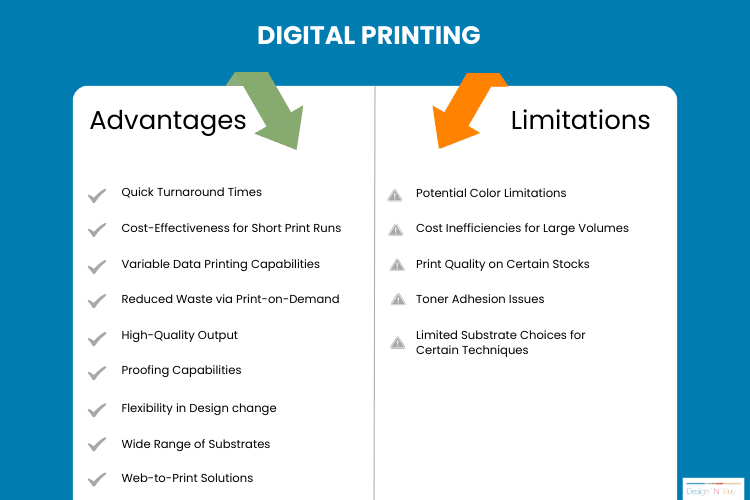Fascination About Digital Printing
Fascination About Digital Printing
Blog Article
Not known Details About Digital Printing
Table of ContentsThe Best Strategy To Use For Digital PrintingGetting The Digital Printing To Work4 Simple Techniques For Digital PrintingDigital Printing for BeginnersWhat Does Digital Printing Do?Not known Facts About Digital Printing
Variable information printing, such as straight mail with customized codes and addresses, is ideally suited for digital printing. Digital fast printing just needs 4 actions of style, review, printing and binding to obtain everything done. Digital quick printing has an exceptional advantage: print on demand.According to PMMI, electronic printing enables brands and makers to respond swiftly to customer demands while improving the supply chain, decreasing warehousing price and waste, and enjoying faster time to market. That all audios excellent, but just how does this technology do all that? The significant differentiator of these innovations is that there are no set-up charges and no plates with electronic printing.
Some Known Factual Statements About Digital Printing
This results in quicker turnaround time and reduces price when making use of electronic printing.
Digital printing is extremely versatile, so it's simple to make adjustments to the plan layout promptly. It all goes back to the plates.
Extra supply can indicate even more waste in the future. With traditional printing techniques, short-run printing is just not possible. Since a fantastic design can make or damage your item, digital printing consistently creates premium, clear and vibrant graphics each time. Digital printing on flexible bags includes the brilliant, dynamic, and precise graphics that almost bid customers to connect and touch them.
Digital printing is the procedure of printing digital-based pictures directly onto a selection of media substratums. There is no need for a printing plate, unlike with countered printing. Digital data such as PDFs or desktop posting data can be sent straight to the electronic printing press to publish on paper, image paper, canvas, material, synthetics, cardstock and various other substrates.
Indicators on Digital Printing You Should Know
According to PMMI, electronic printing allows brands and manufacturers to react quickly to client needs while enhancing the supply chain, reducing warehousing expense and waste, and enjoying faster time to market. That all noises great, however just how does this technology do all that? The major differentiator of these innovations is that there are no set up charges and no plates with electronic printing.
According to Wikipedia, the best distinction in between electronic printing and conventional approaches such as lithography, flexography, gravure, or letterpress is that there is no demand to replace printing plates in digital printing, whereas in these analog printing methods the plates are consistently changed. This causes quicker turn-around time and reduces price when utilizing digital printing.

Digital Printing Can Be Fun For Everyone
More inventory can imply more waste in the future. With standard printing methods, short-run printing is just not feasible. Because a wonderful layout can make or break your product, digital printing consistently creates premium, clear and colorful graphics each visite site time. Digital printing on flexible bags includes the brilliant, dynamic, and specific graphics that practically bid customers to reach out and touch them.

According to PMMI, electronic printing enables brands and producers to respond quickly to consumer needs while improving the supply chain, decreasing warehousing cost and waste, and delighting in faster time to market. That all sounds fantastic, yet how does this modern technology do all that? The significant differentiator of these innovations is that there are no set-up costs and no plates with digital printing.
The Buzz on Digital Printing
According to Wikipedia, the best distinction between electronic printing and conventional approaches such as lithography, flexography, gravure, or letterpress is that there is no need to change printing plates in digital printing, whereas in these analog printing techniques home plates are repetitively changed. This leads to quicker turn-around time and decreases cost when using electronic printing.
Speedy manufacturing implies obtaining your item to market faster. It likewise suggests it's much easier and faster to make adjustments later on, when you alter a dish, add a SKU, or develop seasonal packaging. Digital printing is extremely adaptable, so it's very easy to make changes to the plan design rapidly. All of it returns to the plates.

All about Digital Printing
Digital printing is the process of printing digital-based pictures straight onto a range of media substratums. There is no requirement for a printing plate, unlike with balanced out printing. Digital data such as PDFs or desktop posting data can be sent directly to the digital printing press to print theoretically, picture paper, canvas, material, synthetics, cardstock and other substratums.
Report this page